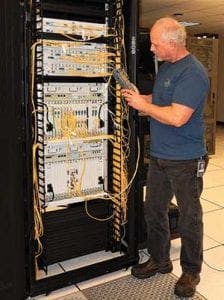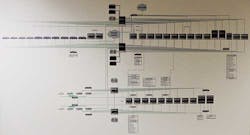Fiber Optic Challenges From a Campus Perspective
The implementation of fiber optic technology continues to evolve, and those who work with the technology must adapt to the demands of high-speed transmission requirements. This includes addressing adds, moves, and changes from legacy installations to keeping up with bandwidth demands through constant upgrades. In this article I address how fiber optic technology is implemented and maintained at the University of Washington (UW) in Seattle.
Encompassing 500 buildings spread out over 700 acres, and having at staff of 22,000 with enrollment of 48,000, one can imagine the bandwidth requirement to support the various needs for voice, video, and data, demands. In addition to several satellite campuses, the UW has a single-mode ring transmitting at terabit levels which surrounds Lake Washington linking to data centers, campuses (K-20), medical centers, and "meet-me" locations.
InvisiLight® Solution for Deploying Fiber
April 2, 2022Go to Market Faster. Speed up Network Deployment
April 2, 2022Episode 10: Fiber Optic Closure Specs Explained…
April 1, 2022Food for Thought from Our 2022 ICT Visionaries
April 1, 2022As with all local area networks dating back to the 1980s, the use of legacy multimode systems has evolved to high-speed Dense Wavelength Division Multiplexing (DWDM single-mode) optical systems. Each of these need to be installed and maintained per stringent requirements which the Network Architecture and Design group performs, administers, and updates, as needed. For physical plant design, installation, and maintenance, the Communications Infrastructure group handles these roles. These groups design, create, build, manage, and document, all fiber circuits as needed.
DWDM equipment being tested by UW staff member (Courtesy of University of Washington)
Due to the size of the campus and high bandwidth needs, the university contracts out duct and cable installations along with related splicing, testing, and emergency restorations. This requires making sure that approved contractors are used, and that their work is in compliance with the university’s practices and documentation requirements.
The UW fiber systems includes a ring around Lake Washington of which they own 2 of the fibers. Due to the low fiber count, this requires the use of DWDM technology to maximize the number of wavelengths as required, which is currently 45. Nodes are located at the University of Washington’s ADS building, the branch campus in Bothell, Bellevue City Hall, the RCECC building in Renton, VCOM in Auburn, King County Data Center within the Sabey Complex, and the UW Router Room within the Westin Building — all of which are secured with locked cabinets.
Other installations throughout the system includes legacy cables with up to 96 single-mode fibers, newer cables with higher count 144, and 288 single-mode fibers. Internally, the use of multimode OM 3 and 4 fibers are used with LC and MTP connectors while most single-mode terminations are with SC/PC and LC connections. While most of the new installations and upgrades use single-mode fibers there is an extensive network of legacy OM-1 multimode fibers still in place. In the data centers these are gradually being upgraded to the higher bandwidth laser optimized OM 3 and OM 4 multimode fibers.
Challenges of operating and maintaining an extensive wide area network along with enterprise operations means a blend of fiber types, manufacturers, and connector styles and polishes. The migration to standardize is an ongoing challenge but one that is being addressed by the implementation of their practices and procedure documentation. It also requires an inventory of test equipment for testing both single-mode and multimode fiber equipment and spans.
UW Network Map (Courtesy University of Washington)
Even with the use of approved contractors, the UW teams must make sure that details including installations are correctly installed with complete documentation and fiber-routing information.
Test requirements and associated documentation is essential, and includes attenuation measurements, OTDR records including splice and distance data, and bi-directional 1310/1550 nm measurements.
Single-mode fiber characterization includes optical return loss (ORL), return loss (RL) chromatic and polarization values for the spans. Test results are provided by contractors on compact disks. Once all measurements are in compliance then the project is approved.
Cable management with a blend of multimode and single-mode terminations. (Courtesy University of Washington)
The University of Washington’s network also provides services throughout Washington state but also to universities in Alaska, Hawaii, and Montana. Like all networks, history repeats itself, and outages can and will occur. While all network designers try to minimize outages through careful planning, outages still occur. Recently one was caused by a construction project involving a contractor boring off site which caused damaged to multiple cables. Fortunately, while the system was ring-protected, if a second cut occurred this would have dropped and isolated thousands of users.
The staff at the UW needs to maintain their network, and provide immediate response for any degradation and or failure. Maintaining staff knowledge of technology, plus having the proper equipment to locate, identify, and resolve, problems is essential. Unlike telephone and cable television operators, which use only single-mode fibers, the UW, like many campuses and organizations, operate a blend of multimode and single-mode systems.
Other types of network that have a blend of fiber types are research facilities, military organizations, hospitals, and factories with massive automation operations. It is easy to overlook these types of organizations but their fiber networks can be quite extensive, and they have implemented fiber optic systems for decades.
Like this Article?
Subscribe to ISE magazine and start receiving your FREE monthly copy today!
This requires additional expertise, training, and equipment. One challenge many network users have from decades of fiber installations is transitioning from hard copy test reports and even floppy disks. Key is to have up-to-date documentation on all fiber links and systems, from legacy multimode to high-speed DWDM single-mode systems.
Keeping pace with technology while addressing bandwidth challenges are a day-to-day challenge for the University of Washington, which only a few decades ago, operating at high speeds at the time of 4 and 10 Mb/s are today transmitting at 100 Gb/s — with no let-up in sight!
About the Author








